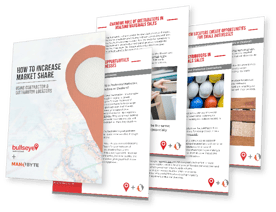How do you track product sales in the real world?
Many building materials manufacturers sell products through distributors, dealers, or independent sales reps. That’s the way it’s been for decades. Needless to say, tracking those offline sales with precision is a challenge.
Traditional manufacturers who fail to account for these transactions are at serious risk of losing money. If you can’t see your customers and what’s driving their actions, you won’t be able to attribute sales accurately or prove an ROI from any online campaigns you run. That is, until now.
Here are some ways you can track your sales, and finally see how your marketing efforts are leading to real-life conversions and sales of your products.
1. Call Tracking
There are several modern software tools that provide insight into customer phone calls. One of these is CallRail.
CallRail, and tools like it, allows you to track customer calls, whether they’re sparked by a print ad or a Facebook ad. Call tracking is also helpful for analyzing online marketing results through phone numbers on social media ads, your dealer locator page, or other pages of your site.

CallRail and similar apps accomplish this with two types of call tracking:
- Dynamic tracking, where the software changes the phone number a customer sees online, depending on the source, to a specific tracking number.
- Static tracking, which lets you use different phone numbers on each webpage or piece of advertising, making it suitable for both online and offline campaigns.
By doing this, there’s no more mystery surrounding the source of a customer’s phone call. You instantly know what ad they’ve seen. You can then “dial in” the results to analyze which forms of offline advertising are most effective for your business. CallRail and similar platforms allow you to monitor the progress of these leads from the first call, all the way through follow-up interactions and the eventual sale, giving you a fuller picture of which offline marketing efforts produce the greatest ROI.
CallRail also allows you to record calls. This is important for assessing lead quality, as customers who call in from a magazine insert or a social media ad may have different levels of buying intent. It also helps you train sales staff and gather valuable customer intelligence.
Finally, call tracking can be the “glue” between your offline and online brand presence. How?
Imagine a customer sees your ad for premium roofing shingles, and then calls in. Via static tracking, you know exactly which ad piqued the lead’s interest. While on the call, one of your sales reps shares a valuable PDF on the 3 best roofing design options for her house, along with the dealer closest to her. She gets this resource by simply signing up online with her email address.
Just like that, your online and offline efforts are joined together into one sales funnel.
Joining offline and online campaigns like this is a great way to see which offline collateral works best in conjunction with certain online marketing tactics. In the end, multi-channel campaigns like this keep leads interested and can show you — from the first tracked offline call to the “ding” of the cash register — the most profitable way to spend on marketing.
2. A Dealer Locator That Generates Leads
Another key part of tracking sales is following what customers do as they choose a local dealer on your website.
This is possible through a smart dealer locator solution, like Bullseye, that’s designed from the bottom-up to help you generate leads.

When a lead searches for dealers near them and picks one, Bullseye dynamically generates an inquiry form. After the lead enters contact info and submits the form, the info is sent both to you and the dealer of interest.
You can then track the next steps in the offline buying process, as the new lead visits that dealer and purchases your product. Over time, you can see which dealers are attracting more leads and converting them into customers. This gives your business an upper hand, as you can prove you’re bringing certain dealers more business than your competitors.
Not to mention, you still have the lead’s information submitted through the inquiry form. This lets you nurture that relationship over time with helpful materials and special deals. You can easily track this in a CRM like HubSpot or Salesforce, both of which work hand-in-hand with Bullseye to provide visibility into the customer journey. Check out 4 examples of building product manufacturers that are using dealer locators effectively.
3. Track Outbound Links in Google Analytics & Tag Manager
Whether your customers are clicking links on your website or in emails, it’s helpful to know what websites they’re going to, why they’re doing it, and to what degree this activity is producing an ROI.
This is especially true for customers clicking through to local dealers and retailers. By using Google Analytics, you can see which campaigns and traffic sources are taking visitors from your site to the dealer they’ll buy from.

Use the following steps in Google Analytics and Google Tag Manager (GTM) to set up events to track outbound link clicks:
- Define a link as an outbound link in GTM by creating a new variable.
- Turn on a link click trigger.
- Create a new tag. This will tell Google Analytics to look for the specific outbound link clicks you’ve indicated, like the ones that take customers to dealer websites.
- Test your new tag. This ensures the tag is correctly identifying outbound links, and that Google Analytics is recording the activity.
4. Discount Codes
One of the easiest and oldest ways to track offline sales is to use discount codes. They’re also attractive to consumers: up to 94% of respondents in one survey admitted to looking for special deals when shopping online.
By utilizing discounts, building materials manufacturers can attract and convince prospects who are seriously considering a purchase, and funnel them towards a certain dealer.
To take advantage of this, create a unique discount code that’s relevant to your brand and will stick out in your customers’ minds. Then, no matter the advertising medium, express the discount offer code in an enticing way.

For example, a lighting manufacturer might use some version of the following:
“Use the code BrightLight50 on our website for 50 percent off your next order of lighting fixtures. Limited time only!”
From here, Google Analytics and Google Tag Manager are your friends yet again. Use them to create custom tags that track when discount codes are entered on your website’s landing pages or dealer inquiry forms.
Follow this process, and you can easily tell which discounts and ads are working best and contributing to more offline sales.
5. Custom Landing Pages
Custom landing pages are great ways to appeal to specific audience segments, highlight a certain local dealer, or generate demand around a certain product line.
They can be “mini-sites” with short, simple domain names that your offline leads can easily type into a web browser, or scan a QR code for with their mobile devices. One key to success is that these pages should be unique. Up to 52% of marketers recycle the same landing page among different marketing campaigns, which means you have a real opportunity to rise above your competitors.

Offering a helpful resource like an informational brochure, video, or checklist on these custom landing pages with a lead capture form lets you instantly have a way to follow up with leads and track conversions.
Another way to use these pages is to point customers to local dealers. You could share relevant local info, testimonials, and special deals to encourage customers to click through.
Google Analytics is a great way to track the performance of these custom pages. By defining a conversion goal and looking at your goal sets, you can see exactly how many sales can be attributed to them.
Custom pages can be set up manually, however, the best way forward is to use an intelligent dealer locator software like Bullseye. Our platform dynamically creates as many local, unique Where-to-Buy landing pages as needed to represent your business’ footprint and reach customers wherever they are.
Bullseye also makes it much easier and more scalable to update these pages whenever local dealer info changes.
6. Follow Up Email Sequences after Sample Requests
Email marketing can lead to a significant boost in your marketing ROI, as it represents an average of $42 in revenue for every $1 spent.
Specifically, sending emails to those who have requested samples of your products is a great way to keep high-intent leads moving towards the sale.
Let’s say you’re a carpet manufacturer, and a web user lands on your page, highly interested in a certain carpet style. He orders three samples through your site in order to help make a decision, and of course, enters his name and phone number in the process.

Your sales reps can then follow up with him via phone to assist even more in the decision-making process. At the same time, you can have an email autoresponder series going out to share more helpful information, point the customer to the closest dealer, and offer special deals.
This process doesn’t apply to all building materials manufacturers, of course, but email follow-up is a great way to follow interested customers from the sample request to the ultimate decision to buy. Do this a few times, and you can start to refine your email campaigns based on what converts customers the most.
Tracking Offline Building Materials Sales is Simple With the Right Process and Tools
Gone are the days where it was impossible to figure out ROI from offline sales, or being resigned to having a vague sense of it through revenue numbers.
You can now use the power of the internet, with the many premium software and analytics tools available, to understand exactly how much your brand presence is turning into real-world sales. Whether a building materials manufacturer uses billboards, radio commercials, social media, or SEO, it’s now a simple endeavor to track customer engagement all the way from the first contact to the point of sale.
Just keep in mind…some ways of doing it are easier, more scalable, and less resource-intensive than others.
The Bullseye Dealer Locator software does a lot of heavy lifting in tracking offline sales by capturing and sharing lead information with dealers, generating local landing pages, and integrating seamlessly with your CRM and other tools to track customer journeys.
Bullseye lets you know just what marketing pieces and campaigns are raising your bottom line. If you’re ready to see the difference, contact us today to get an assessment of your current dealer locator page.
Get Advanced Marketing Resources

Learn how building materials manufacturers can intercept demand and increase market share using their locators. Download our free guide today for advanced practices and insights!
Related Posts
How to Implement Successful Locator Onboarding

3 Types of Businesses that can Benefit from Local Pages







